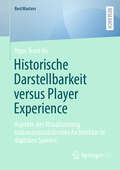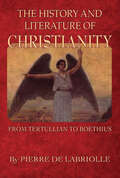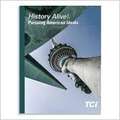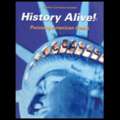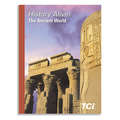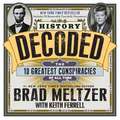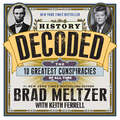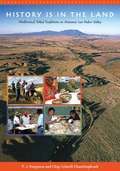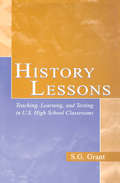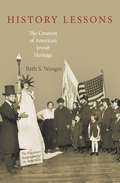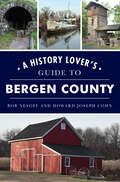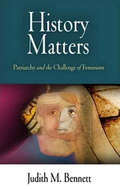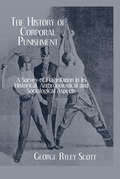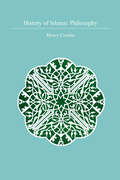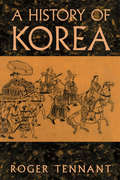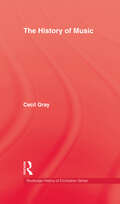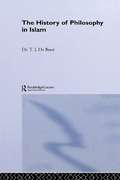- Table View
- List View
Historiography: Ancient, Medieval, and Modern
by Ernst BreisachIn this pioneering work, Ernst Breisach presents an effective, well-organized, and concise account of the development of historiography in Western culture. Neither a handbook nor an encyclopedia, this up-to-date third edition narrates and interprets the development of historiography from its origins in Greek poetry to the present, with compelling sections on postmodernism, deconstructionism, African-American history, women’s history, microhistory, the Historikerstreit, cultural history, and more. The definitive look at the writing of history by a historian, Historiography provides key insights into some of the most important issues, debates and innovations in modern historiography. Praise for the first edition: “Breisach’s comprehensive coverage of the subject and his clear presentation of the issues and the complexity of an evolving discipline easily make his work the best of its kind.”—Lester D. Stephens, American Historical Review
Historisch-Genetische Theorie (essentials)
by Gerda Bohmann Heinz-Jürgen NiedenzuDie historisch-genetische Theorie verfolgt den Anspruch, die Genese der menschlichen kulturellen Lebensweise aus den naturgeschichtlichen Ausgangsbedingungen und die historisch differenten gesellschaftlichen Organisationsformen in ihrer Strukturfolge erklären zu können. Für die Theorie zentral ist das methodologische Primat ontogenetischer Entwicklungsprozesse. Die gesellschaftlichen Organisationsformen sind diesen konstruktiv verbunden, folgen in ihrer Entwicklung aber anderen Mechanismen. Es werden die Grundlagen der Theorie herausgearbeitet und auf deren zentrale Fragen und Themenbereiche eingegangen.
Historische Darstellbarkeit versus Player Experience: Aspekte der Visualisierung nationalsozialistischer Architektur in digitalen Spielen (BestMasters)
by Ngoc Tram VuUnterhaltungsspiele, die im Zusammenhang mit der Handlung und Folge des Zweiten Weltkriegs stehen sowie eine zeitgenössische Aufarbeitung der Verbrechen des Nationalsozialismus veranschaulichen, nutzen häufig narrative und emotionale Elemente zur historischen Inszenierung. Die Darstellung und Rekonstruktion nationalsozialistischer Architektur wurde jedoch in der Forschung zu digitalen Spielen bislang kaum beachtet. Mit diesem Hintergrund untersucht diese Arbeit die visuelle Adaption der NS-Architektur in Gaming-Medien aus unterschiedlichen Jahrzehnten. Die Architektur in digitalen Spielen bildet eine hybride Form, die Fragmente historischer Bauten mit fiktionalen, oft „deutsch-faschistisch“ wahrgenommenen Formen kombiniert. Bestimmte visuelle Anpassungen werden zudem aus Spielmechanik- und Spielerfahrungsgründen neu gestaltet. Die große Diskrepanz zwischen historischen Vorbildern und fiktionalen Interpretationen schafft ein eigenes Genre der Bildsprache, das neue Forschungsansätze für die Architekturgeschichte bietet, aber auch Bedenken bezüglich der möglichen Verharmlosung der NS-Geschichte im heutigen digitalen Zeitalter weckt.
History & Literature Of Christ (The\history Of Civilization Ser.)
by De_LabriolleFirst published in 2007. Routledge is an imprint of Taylor & Francis, an informa company.
History Alive! Pursuing American Ideals
by Diane HartBy using this program, the students will discover how the skills of social sciences are used to explore the history of the United States. The print and online components of this program provide the tools needed for a complete learning cycle. Each unit begins with an online Unit Opener to prepare for inquiry--asking questions and proposing supported answers and solutions. Each lesson with a Lesson Guide preview activity that engages inquiry and sets a foundation for the lesson's content. In the Lesson Guide, student will participate in an interactive activity that connects to both the C3 Framework and English Language Arts and literacy. In these activities, they will use the tools of social studies inquiry: asking questions, using sources and other evidence to develop claims, and communicating conclusions. The lesson concludes as the readers demonstrate their knowledge of the lesson's core ideas and the inquiry process through a variety of paper and online Assessments.
History Alive! Pursuing American Ideals, Student Edition
by Teachers' Curriculum InstituteNIMAC-sourced textbook
History Alive! The Ancient World
by Teachers Curriculum Institute"This program comprises six units with text on Early Humans and the Rise of Civilization, Ancient Egypt and the Middle East, Ancient India, Ancient China, Ancient Greece, and Ancient Rome. Maps, Timeline, Resources, Diagrams and Tables are additional features. "
History Alive! The United States Through Industrialism, Interactive Student Notebook
by Teachers' Curriculum InstituteNIMAC-sourced textbook
History Decoded: The 10 Greatest Conspiracies Of All Time
by Brad Meltzer Keith FerrellIt's an irresistible combination: Brad Meltzer, a born storyteller, counting down the world's most intriguing unsolved mysteries. And to make this richly illustrated book even richer, each chapter invites the reader along for an interactive experience through the addition of removable facsimile documents--the evidence! It's a treasure trove for conspiracy buffs, a Griffin and Sabine for history lovers. Adapted from Decoded, Meltzer's hit show on the HISTORY network, History Decoded explores fascinating, unexplained questions. Is Fort Knox empty? Why was Hitler so intent on capturing the Roman "Spear of Destiny"? What's the government hiding in Area 51? Where did the Confederacy's $19 million in gold and silver go at the end of the Civil War? And did Lee Harvey Oswald really act alone? Meltzer sifts through the evidence; weighs competing theories; separates what we know to be true with what's still--and perhaps forever--unproved or unprovable; and in the end, decodes the mystery, arriving at the most likely solution. Along the way we meet Freemasons, Rosicrucians, Nazi propagandists, and the real DB Cooper. Bound in at the beginning of each story is a custom-designed envelope--a faux 19th-century leather satchel, a U. S. government classified file--containing facsimiles of relevant evidence: John Wilkes Booth's alleged unsigned will, a map of the Vatican, Kennedy's death certificate. The whole is a riveting, interactive adventure through the compelling world of mysteries and conspiracies.
History Decoded: The 10 Greatest Conspiracies of All Time
by Brad Meltzer Keith FerrellIt's an irresistible combination: Brad Meltzer, a born storyteller, counting down the world's most intriguing unsolved mysteries. And to make this richly illustrated book even richer, each chapter invites the reader along for an interactive experience through the addition of facsimile documents—the evidence! It's a treasure trove for conspiracy buffs, a Griffin and Sabine for history lovers. <P><P>Adapted from Decoded, Meltzer’s hit show on the HISTORY network, History Decoded explores fascinating, unexplained questions. Is Fort Knox empty? Why was Hitler so intent on capturing the Roman “Spear of Destiny”? What’s the government hiding in Area 51? Where did the Confederacy’s $19 million in gold and silver go at the end of the Civil War? And did Lee Harvey Oswald really act alone? <P>Meltzer sifts through the evidence; weighs competing theories; separates what we know to be true with what’s still—and perhaps forever—unproved or unprovable; and in the end, decodes the mystery, arriving at the most likely solution. Along the way we meet Freemasons, Rosicrucians, Nazi propagandists, and the real DB Cooper. <P>At the beginning of each story is a custom-designed envelope—a faux 19th-century leather satchel, a U.S. government classified file—containing facsimiles of relevant evidence: John Wilkes Booth’s alleged unsigned will, a map of the Vatican, Kennedy’s death certificate. The whole is a riveting, interactive adventure through the compelling world of mysteries and conspiracies.
History Is in the Land: Multivocal Tribal Traditions in Arizona's San Pedro Valley
by Chip Colwell-Chanthaphonh Robert W. Preucel T. J. FergusonArizona's San Pedro Valley is a natural corridor through which generations of native peoples have traveled for more than 12,000 years, and today many tribes consider it to be part of their ancestral homeland. This book explores the multiple cultural meanings, historical interpretations, and cosmological values of this extraordinary region by combining archaeological and historical sources with the ethnographic perspectives of four contemporary tribes: Tohono O'odham, Hopi, Zuni, and San Carlos Apache. Previous research in the San Pedro Valley has focused on scientific archaeology and documentary history, with a conspicuous absence of indigenous voices, yet Native Americans maintain oral traditions that provide an anthropological context for interpreting the history and archaeology of the valley. The San Pedro Ethnohistory Project was designed to redress this situation by visiting archaeological sites, studying museum collections, and interviewing tribal members to collect traditional histories. The information it gathered is arrayed in this book along with archaeological and documentary data to interpret the histories of Native American occupation of the San Pedro Valley. This work provides an example of the kind of interdisciplinary and politically conscious work made possible when Native Americans and archaeologists collaborate to study the past. As a methodological case study, it clearly articulates how scholars can work with Native American stakeholders to move beyond confrontations over who "owns" the past, yielding a more nuanced, multilayered, and relevant archaeology.
History Lessons: Teaching, Learning, and Testing in U.S. High School Classrooms
by S.G. GrantIn this book, extended case studies of two veteran teachers and their students are combined with the extant research literature to explore current issues of teaching, learning, and testing U.S. history. It is among the first to examine these issues together and in interaction. While the two teachers share several similarities, the teaching practices they construct could not be more different. To explore these differences, the author asks what their teaching practices look like, how their instruction influences their students' understandings of history, and what role statewide exams play in their classroom decisions. History Lessons: Teaching, Learning, and Testing in U.S. High School Classrooms is a major contribution to the emerging body of empirical research in the field of social studies education, chiefly in the subject area of history, which asks how U.S. students make sense of history and how teachers construct their classroom practices. Three case study chapters are paired with three essay review chapters intended to help readers analyze the cases by looking at them in the context of the current research literature. Two concluding chapters extend the cases and analyses: the first looks at how and why the teachers profiled in this book construct their individual teaching practices, in terms of three distinct but interacting sets of influences--personal, organizational, and policy factors; the second explores the prospects for promoting what the author defines as ambitious teaching and learning. Many policymakers assume that standards-based reforms support the efforts of ambitious teachers, but until we better understand how they and the students in their classes think and act, that assumption is hollow at best. This book is a must have for faculty and students in the field of social studies education, and broadly relevant across the fields of curriculum studies and educational policy.
History Lessons: The Creation of American Jewish Heritage
by Beth S. WengerMost American Jews today will probably tell you that Judaism is inherently democratic and that Jewish and American cultures share the same core beliefs and values. But in fact, Jewish tradition and American culture did not converge seamlessly. Rather, it was American Jews themselves who consciously created this idea of an American Jewish heritage and cemented it in the popular imagination during the late nineteenth and mid-twentieth centuries. History Lessons is the first book to examine how Jews in the United States collectively wove themselves into the narratives of the nation, and came to view the American Jewish experience as a unique chapter in Jewish history.Beth Wenger shows how American Jews celebrated civic holidays like Thanksgiving and the Fourth of July in synagogues and Jewish community organizations, and how they sought to commemorate Jewish cultural contributions and patriotism, often tracing their roots to the nation's founding. She looks at Jewish children's literature used to teach lessons about American Jewish heritage and values, which portrayed--and sometimes embellished--the accomplishments of heroic figures in American Jewish history. Wenger also traces how Jews often disagreed about how properly to represent these figures, focusing on the struggle over the legacy of the Jewish Revolutionary hero Haym Salomon.History Lessons demonstrates how American Jews fashioned a collective heritage that fused their Jewish past with their American present and future.
History Lover's Guide to Bergen County, A (Landmarks)
by Bob Nesoff Howard Joseph CohnFrom the crossroads of the American Revolution to the construction of the George Washington Bridge, New Jersey's Bergen County has a history that has shaped not only the metropolitan area, but the nation itself. Featuring narratives of key historical moments, legendary personalities and fascinating landmarks, this guide to Bergen County's past is essential for any resident or visitor alike. Take a copy along as you traverse the county and discover the historic sites within and the stories behind them. Authors Bob Nesoff and Howard Joseph Cohn take readers on a fascinating journey through Bergen County's incredible past.
History Matters
by Judith M. BennettWritten for everyone interested in women's and gender history, History Matters reaffirms the importance to feminist theory and activism of long-term historical perspectives. Judith M. Bennett, who has been commenting on developments in women's and gender history since the 1980s, argues that the achievement of a more feminist future relies on a rich, plausible, and well-informed knowledge of the past, and she asks her readers to consider what sorts of feminist history can best advance the struggles of the twenty-first century.Bennett takes as her central problem the growing chasm between feminism and history. Closely allied in the 1970s, each has now moved away from the other. Seeking to narrow this gap, Bennett proposes that feminist historians turn their attention to the intellectual challenges posed by the persistence of patriarchy. She posits a "patriarchal equilibrium" whereby, despite many changes in women's experiences over past centuries, women's status vis-à-vis that of men has remained remarkably unchanged. Although, for example, women today find employment in occupations unimaginable to medieval women, medieval and modern women have both encountered the same wage gap, earning on average only three-fourths of the wages earned by men. Bennett argues that the theoretical challenge posed by this patriarchal equilibrium will be best met by long-term historical perspectives that reach back well before the modern era. In chapters focused on women's work and lesbian sexuality, Bennett demonstrates the contemporary relevance of the distant past to feminist theory and politics. She concludes with a chapter that adds a new twist--the challenges of textbooks and classrooms--to viewing women's history from a distance and with feminist intent.A new manifesto, History Matters engages forthrightly with the challenges faced by feminist historians today. It argues for the radical potential of a history that is focused on feminist issues, aware of the distant past, attentive to continuities over time, and alert to the workings of patriarchal power.
History Of Bundling: Its Origin, Progress, And Decline In America
by StilesFirst published in 2006. Routledge is an imprint of Taylor & Francis, an informa company.
History Of Chivalry Vol I: In Two Volumes, Volume 2
by MillsFirst published in 2005. Routledge is an imprint of Taylor & Francis, an informa company.
History Of Corporal Punishment
by ScottFirst published in 2005. Routledge is an imprint of Taylor & Francis, an informa company.
History Of Islamic Philosophy
by Henry CorbinFirst published in 1993. Published here for the first time in English, this highly important work by Henry Corbin, the Islamic scholar, philosopher and historian of religion, is a definitive interpretation of traditional Islamic philosophy from the beginning to the present day. In this authoritative volume, Corbin makes clear the great themes of the doctrinal and mystical vision of lslamic philosophy through a wealth of comparative parallels and in relation to the most profound currents of Western philosophy. In Part One, From the Beginning Down to the Death of Averroes, Corbin considers the Sources of Philosophical Meditation in Islam; Shi ism and Prophetic Philosophy; the Sunni Kalam; Philosophy and the Natural Sciences; the Hellenizing Philosophers; Sufism; Al-Suhrawardi and the Philosophy of Light, and the Andalusian Tradition. In Part Two, From the Death of Averroes to the Present Day, he examines Sunni Thought, the Metaphysics of Sufism, and Shiite Thought. Corbin's History of Islamic Philosophy is both an inspirational book and an essential work of reference, enabling readers to discover themselves the richness of this body of thought.
History Of Japanese Food
by IshigeFirst published in 2001. Routledge is an imprint of Taylor & Francis, an informa company.
History Of Korea
by Tennant"Go with me to a land whose life for ages has been a mystery", wrote a 19th-century visitor to Korea, "a land which from time unknown has kept aloof, whose people might have been the denizens of another planet". He may not have known that in the 4th century AD they had controlled much of north-east Asia and in the 8th their ships had dominated the trade of the Yellow Sea, nor did he guess the astonishing transformation that lay ahead of Korea in the 20th century - all of which are chronicled here. This is the first full-length general history of the country to be published in Britain, and incorporates in its early chapters Chinese and Korean material not previously published in any Western language. Beginning with the prehistoric era, the book provides a uniquely detailed treatment of the earlier periods in Korea's evolution. The work progresses through the era of the Three Kingdoms, Silla, Koguryo and Paekche; the Koryo period (918-1392 AD) which saw the war with the Khitan, the coming of the Mongols and the invasion of Japan; and the rule of the Yi dynasty from 1392 to 1910, which saw the flowering of Korean Confucianism, the invasion of Hideyoshi, the Manchu invasion, long periods of isolation and then the opening of the country to the West. Following this came the decades (1910-1945) when Korea was under Japanese rule; the period of the Sino-Japanese war, the Russo-Japanese war and Asian co-prosperity. Moving towards the present day, the work concludes with the story of the two Koreas and the drawing of the line between them, South Korea's economic successes and the adoption of a new constitution in 1987. Full and accurate records of all the significant persons and dates are provided, including events in China and Japan in so far as they involved Korea. Richly descriptive, with an emphasis on skilfull accounts of the major occurrences, battles and court scandals of the times, this lucidly written history makes absorbing reading, and should be welcomed by the general reader.
History Of Music: Music Book Index (The\history Of Civilization Ser.)
by CecilFirst published in 2005. Routledge is an imprint of Taylor & Francis, an informa company.
History Of Philosophy In Islam
by J T DenBoerThis is a pre-1923 historical reproduction that was curated for quality. Quality assurance was conducted on each of these books in an attempt to remove books with imperfections introduced by the digitization process. Though we have made best efforts - the books may have occasional errors that do not impede the reading experience. We believe this work is culturally important and have elected to bring the book back into print as part of our continuing commitment to the preservation of printed works worldwide.


